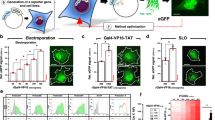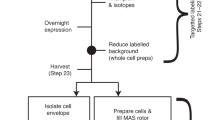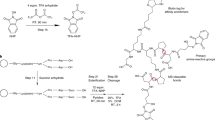Abstract
We describe a high-throughput in-cell nuclear magnetic resonance (NMR)-based method for mapping the structural changes that accompany protein-protein interactions (STINT-NMR). The method entails sequentially expressing two (or more) proteins within a single bacterial cell in a time-controlled manner and monitoring the protein interactions using in-cell NMR spectroscopy. The resulting spectra provide a complete titration of the interaction and define structural details of the interacting surfaces at atomic resolution.
This is a preview of subscription content, access via your institution
Access options
Subscribe to this journal
Receive 12 print issues and online access
$259.00 per year
only $21.58 per issue
Buy this article
- Purchase on Springer Link
- Instant access to full article PDF
Prices may be subject to local taxes which are calculated during checkout


Similar content being viewed by others
References
Uetz, P. et al. A comprehensive analysis of protein-protein interactions in Saccharomyces cerevisiae. Nature 403, 623–627 (2000).
Rain, J.C. et al. The protein-protein interaction map of Helicobacter pylori. Nature 409, 211–215 (2001).
Gerstein, M. Integrative database analysis in structural genomics. Nat. Struct. Biol. 7 (Suppl.), 960–963 (2000).
Serber, Z. & Dotsch, V. In-cell NMR spectroscopy. Biochemistry 40, 14317–14323 (2001).
Lutz, R. & Bujard, H. Independent and tight regulation of transcriptional units in Escherichia coli via the LacR/O, the TetR/O and AraC/I1–I2 regulatory elements. Nucleic Acids Res. 25, 1203–1210 (1997).
Zuger, S. & Iwai, H. Intein-based biosynthetic incorporation of unlabeled protein tags into isotopically labeled proteins for NMR studies. Nat. Biotechnol. 23, 736–740 (2005).
Pickart, C.M. & Eddins, M.J. Ubiquitin: structures, functions, mechanisms. Biochim. Biophys. Acta 1695, 55–72 (2004).
Di Fiore, P.P., Polo, S. & Hofmann, K. When ubiquitin meets ubiquitin receptors: a signalling connection. Nat. Rev. Mol. Cell Biol. 4, 491–497 (2003).
Bache, K.G., Raiborg, C., Mehlum, A. & Stenmark, H. STAM and Hrs are subunits of a multivalent ubiquitin-binding complex on early endosomes. J. Biol. Chem. 278, 12513–12521 (2003).
Shekhtman, A. & Cowburn, D. A ubiquitin-interacting motif from Hrs binds to and occludes the ubiquitin surface necessary for polyubiquitination in monoubiquitinated proteins. Biochem. Biophys. Res. Commun. 296, 1222–1227 (2002).
Mizuno, E., Kawahata, K., Kato, M., Kitamura, N. & Komada, M. STAM proteins bind ubiquitinated proteins on the early endosome via the VHS domain and ubiquitin-interacting motif. Mol. Biol. Cell 14, 3675–3689 (2003).
Fisher, R.D. et al. Structure and ubiquitin binding of the ubiquitin-interacting motif. J. Biol. Chem. 278, 28976–28984 (2003).
Young, P., Deveraux, Q., Beal, R.E., Pickart, C.M. & Rechsteiner, M. Characterization of two polyubiquitin binding sites in the 26 S protease subunit 5a. J. Biol. Chem. 273, 5461–5467 (1998).
Groll, M., Bochtler, M., Brandstetter, H., Clausen, T. & Huber, R. Molecular machines for protein degradation. ChemBioChem. 6, 222–256 (2005).
Riek, R., Pervushin, K. & Wuthrich, K. TROSY and CRINEPT: NMR with large molecular and supramolecular structures in solution. Trends Biochem. Sci. 25, 462–468 (2000).
Acknowledgements
This work was supported by grants to A.S. (American Diabetes Association Career Development Award 1-06-CD-23) and to D.C. (National Institutes of Health 2R01GM047021-13A2).
Author information
Authors and Affiliations
Corresponding author
Ethics declarations
Competing interests
The authors declare no competing financial interests.
Supplementary information
Supplementary Fig. 1
SDS-PAGE of ubiquitin and STAM2 sequential expression. (PDF 207 kb)
Supplementary Fig. 2
Overlay of 1H{15N}HSQC-spectra of E. coli cells after 3 hour over-expression of [U-, 15N] AUIM and 0 h (red), 2h (yellow), and 3 h (blue) over-expression of ubiquitin. (PDF 136 kb)
Supplementary Fig. 3
Overlay of 1H{15N}HSQC-spectra of E. coli cells after 3 hour over-expression of [U-, 15N] ubiquitin (red) and purified [U-, 15N] ubiquitin (black) in 10 mM phosphate buffer [pH 6.8]. (PDF 146 kb)
Supplementary Fig. 4
Overlay of 1H{15N}HSQC-spectra of E. coli cells after 3 hour over-expression of [U-, 15N] ubiquitin and 0 h (red), 2h (blue), and 3 h (yellow) over-expression of mutant AUIM (SA16). (PDF 117 kb)
Supplementary Fig. 5
Differential broadening of selected peaks from the 1H{15N}HSQC-spectrum of E. coli cells after 3 hour overexpression of [U-, 15N] ubiquitin and 0 h (red), 2 h (blue), and 3 h (green) overexpression of STAM2. (PDF 195 kb)
Supplementary Fig. 6
1H{15N}HSQC-spectrum of the supernatant of the NMR sample after E. coli cells over-expressing [U-15N] ubiquitin were removed by centrifugation. (PDF 104 kb)
Supplementary Fig. 7
1H{15N}HSQC-spectrum of the E. coli cells grown on [U-15N] M9 medium without protein over-expression. (PDF 89 kb)
Rights and permissions
About this article
Cite this article
Burz, D., Dutta, K., Cowburn, D. et al. Mapping structural interactions using in-cell NMR spectroscopy (STINT-NMR). Nat Methods 3, 91–93 (2006). https://doi.org/10.1038/nmeth851
Received:
Accepted:
Published:
Issue Date:
DOI: https://doi.org/10.1038/nmeth851
This article is cited by
-
Active metabolism unmasks functional protein–protein interactions in real time in-cell NMR
Communications Biology (2020)
-
Characterization of proteins by in-cell NMR spectroscopy in cultured mammalian cells
Nature Protocols (2016)
-
Caught in Action: Selecting Peptide Aptamers Against Intrinsically Disordered Proteins in Live Cells
Scientific Reports (2015)
-
Real-time and simultaneous monitoring of the phosphorylation and enhanced interaction of p53 and XPC acidic domains with the TFIIH p62 subunit
Oncogenesis (2015)
-
Efficient cellular solid-state NMR of membrane proteins by targeted protein labeling
Journal of Biomolecular NMR (2015)



